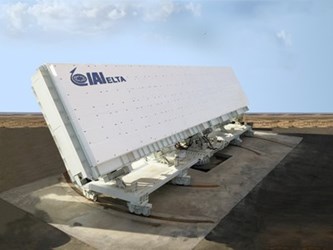IAI Unveils Stealth-Tracking UHF Radar

Israel Aerospace Industries (IAI) has unveiled a unique, highly advanced family of modular Ultra High Frequency (UHF) Active Electronically Scanned Array (AESA) Radars.
The new ULTRA family of AESA UHF radars, developed by IAI's ELTA Systems Group and subsidiary, represents a formidable capability of Early Warning and long range search and tracking of low observable (stealth) aircraft, Air Breathing Targets (ABTs), and ballistic missiles. The radars offer an advantage of low RCS targets detection at long ranges, operation under all weather conditions, and in the presence of dense electromagnetic environments.
The ULTRA radars, already operationally proven, use a modular, common UHF-band cluster architecture capable of wide angle electronic scan in both elevation and azimuth. The basic cluster can be modularly scaled to 6 and up to a 22 cluster configuration which offers extended detection ranges and tracking accuracies. Other cluster configurations are possible to meet specific customer's requirements.
The ULTRA-C1 (single cluster configuration) is a lightweight mobile system designed to provide an autonomous search and detection capability up to 500km for a typical fighter aircraft. The ULTRA-C6 (six clusters configuration) is designed for an Early Warning and long range of satellites, ballistic missiles and airborne targets at long ranges, while the ULTRA C-22 (22 clusters configuration) is a strategic system for ballistic missiles and space objects detection and tracking at very long ranges.
The ULTRA radars can be used as autonomous search radar, supporting all defence layers: Air Defence Surveillance for medium range, Early Warning system for long ranges, and a strategic system for very long ranges.
"Ballistic missiles present a significant global threat to nations, expeditionary forces and global peace-keeping missions", explained Mr. Nissim Hadas, IAI Executive VP & ELTA President, "We note increasing requirements worldwide for Early Warning radars, in order to extend the currently available Air Situation Picture and allow commanders and decision makers the valuable extra time for making informed and educated decisions concerning necessary defensive measures."
Source: Israel Aerospace Industries
